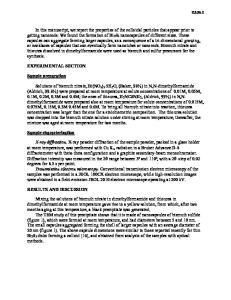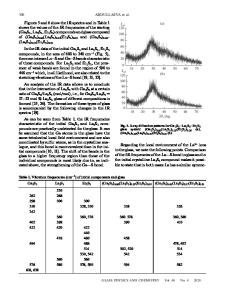Organic Synthesis with Different OA/EHA Ratios of Sb 2 S 3 Nanowires of Flower-Like Organization and [010] Orientation
- PDF / 673,590 Bytes
- 5 Pages / 593.972 x 792 pts Page_size
- 26 Downloads / 438 Views
st interesting sulfide materials is antimony trisulfide (Sb2S3) that crystallizes in the orthorhombic system (pbnm space group).[1] It is well known that stibnite (Sb2S3) is a common mineral.[2] As a member of V-VI group binary chalcogenides possessing good photosensitivity and high thermoelectric power, it is regarded as a promising material for solar energy conversion because of its band gap that covers the range of the solar spectrum.[3] Therefore, various methods have been employed to synthesize this material at the nanoscale.[4–6] Sb2S3 nanostructures with different morphologies and architectures were prepared by some convenient methods,[6–8] but colloidal organic syntheses of antimony trisulfide (Sb2S3) nanomaterials are rare in the scientific papers. So far, Deng et al.[9] reported the first synthesis of Sb2Se3 xSx nanotubes across the entire compositional range (x = 0 to 3) via a colloidal synthetic method. We report the first synthesis of the Sb2S3 nanorods/bars by the modified colloidal synthetic method.[10] Until now, the developments regarding the synthesis of this material are few, especially related to the growth using organic colloidal methods.
IVANA Lj. VALIDZˇIC´, Senior Scientific Associate, and NADICA D. ABAZOVIC´, Scientific Associate, are with the Laboratory for Radiation Chemistry and Physics, Vincˇa Institute of Nuclear Sciences, University of Belgrade, 11001 Belgrade, Serbia. Contact e-mail: [email protected]. MIODRAG MITRIC´, Scientific Adviser, is with the Laboratory for Theoretical and Condensed Matter Physics, Vincˇa Institute of Nuclear Sciences, University of Belgrade Manuscript submitted September 16, 2011. Article published online March 3, 2012 METALLURGICAL AND MATERIALS TRANSACTIONS A
In this article, organic colloidal synthesis by using different oleic acid (OA)/2-ethylhexanoic acid (EHA) ratio was reported for the first time. We found that all synthesized Sb2S3 nanowires show the flower-like organization and that the optical band-gap energy is independent of OA/EHA ratio. Also, Sb2S3 nanowires grow predominantly along the [010] direction, and a significant decrease in unit cell parameters a, b, and c followed by decreasing the OA/EHA ratio was observed. It seems that the shorter branched hydrocarbon chain in excess leads to the better structural stability. No similar results were found in the literature concerning the as-synthesized Sb2S3 nanomaterial. All chemicals (antimony [III] chloride [SbCl3] [99.0 pct min Alfa Aesar, Ward Hill, MA], sulfur powder [S] [99.999 pct Alfa Aesar], paraffin liquid [J.T. Baker, Phillipsburg, NJ], OA [C18H34O2] [65 pct GC Fluka; Sigma Aldrich, St. Louis, MO], EHA [99 pct, Alfa Aesar), oleylamine techn. [70 pct Sigma Aldrich], hexan [J.T. Baker], isopropyl alcohol [J.T. Baker], methanol [J.T. Baker], and benzene [J.T. Baker]) were of the highest purity available, and they were used without subsequent purification. In a typical synthesis of Sb2S3 nanowires of flower-like organization, both the Sb(III)-complex precursor solution and sulfur precursor solution were prepar
Data Loading...










